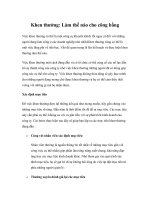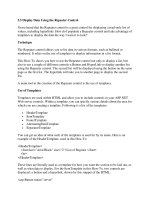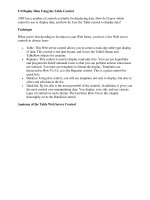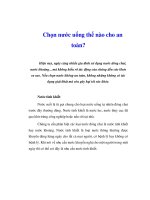Tài liệu INSTRUCTIONS FOR USING THE COACHING SKILLS ASSESSMENT TOOL doc
Bạn đang xem bản rút gọn của tài liệu. Xem và tải ngay bản đầy đủ của tài liệu tại đây (46.67 KB, 6 trang )
INSTRUCTIONS FOR USING THE COACHING SKILLS ASSESSMENT TOOL
The purpose of the assessment is to provide data to help the coach improve his/her coaching skills. A candid evaluation will provide the most help. Be as
specific as possible in your responses. The coach's self-assessment, along with input from their manager/coordinator and from people they coach will provide a
total assessment of the individual's coaching skills.
Please follow these guidelines as you provide input:
• Provide specific examples as often as possible.
• Data should be current.
• If you don't understand a question, ask your manager/coordinator or module Coaching Systems owner for clarification.
• If you don't have any input, write “None.”
• Coachees should evaluate performance based on their own working relationship with the Coach.
• Coach and manager/coordinator should evaluate performance based on their perspective and data on the collective relationships.
COACHING ASSESSMENT TOOL
Date:___________________ Coach's Name: _________________________________ Person Inputting:____________________________________________
INSTRUCTIONS: Considering the Coach's working relationship with his/her coachees, provide examples which exemplify actual behavior for each skill element listed.
CORE COMPETENCIES OF EFFECTIVE COACHING
EXAMPLES OF ACTUAL BEHAVIOR
I. THE ABILITY TO DEVELOP EFFECTIVE 1:1 RELATIONSHIPS (i.e. Build Trust)
a) Takes the time to know coachees personally; their interests, their family,
their values.
b) Is always open and honest with coachees, respects confidentiality, and
considers their personal needs. Demonstrates a genuine commitment to the
coachees.
c) Has clear expectations with each coachee, including mutually understood
results, standards and decision space.
d) Shows respect for coachees by providing helpful suggestions and advice
that allows them to do a better job and by acknowledging their
contributions and abilities.
II. THE ABILITY TO HANDLE CONFLICT (i.e., using Principle Based Decision Making on issues involving coachees)
a) Is willing to deal with conflict that involves coachees.
b) When conflict arises he/she focuses on the problem or issue (facts) instead
of on the coachee or the other people involved.
c) Asks enough questions to understand/clarify the situation.
d) Clarifies the boundaries and principles that apply to the decision.
CORE COMPETENCIES OF EFFECTIVE COACHING (cont’d)
EXAMPLES OF ACTUAL BEHAVIOR
II. THE ABILITY TO HANDLE CONFLICT (cont’d.)
e) Listens to coachee's point of view as well as those of others involved.
Respects everyone involved when taking action (i.e., confrontation,
making decisions, communications, etc.).
f) Gets all the right people together to work the issue including identifying
who has data to provide and who makes the decision.
g) Uses a decision making process that usually results in a win-win solution.
h) Decisions are based upon VMOP (Vision, Mission, Objective, Principles)
and clear, business driven objectives.
III. THE ABILITY TO UNDERSTAND, ACKNOWLEDGE, AND USE DIFFERENT STYLES.
a) Leadership style always seems to fit the situation and people involved
(e.g., directing, coaching, supporting, or delegation) without causing
confusion. Has a strategy for leading each team member and seeks
feedback on the effectiveness of those styles.
b) Understands the different styles used by coachees and leverages the fact
that people of different backgrounds and cultural values can take different
but equally effective approaches to their work.
c) Focuses and confronts biased or culturally inappropriate words, humor,
gestures, and behaviors.
IV. THE ABILITY TO SEE AND CAPITALIZE ON THE POTENTIAL IN OTHERS
a) Helps each coachee to develop an effective skill improvement plan. (e.g.,
Personal Development Plan) that causes them to grow. Periodically checks
progress.
b) Knows what each coachee wants to accomplish during their career at
P&G. Supports those personal goals.
c) Recognizes unique skills of each coachee and builds their self-esteem by
the way he/she rewards their contributions and use of those skills.
d) Provides all coachees opportunities to increase their level of
responsibilities and helps them successfully meet that challenge.
e) Helps coachees increase their decision making space by defining the
boundaries.
V. THE ABILITY TO MAINTAIN ACCOUNTABILITY FOR ACHIEVING RESULTS
a) Have regular discussions on how coachee's assignments fit the business
priorities and why their assignments are important in accomplishing the
business strategy. Each coachee has a work plan.
b) The consequences and measures of success are clear to each coachee in
regard to their commitments and standards.
c) Coachees get the direction they need to do their work. Improvement plans
are developed when mutually agreed upon results are not achieved.
d) Coachees are clear about which decisions they will make and what
decisions the coach or others will make.
V. THE ABILITY TO MAINTAIN ACCOUNTABILITY FOR ACHIEVING RESULTS (cont’d)
e) Frequently discusses progress with each coachee. Provides immediate
feedback when coachees do not meet expectations.
V1. THE ABILITY TO PROVIDE EFFECTIVE AND BALANCED FEEDBACK TO OTHERS
a) Provides timely and frequent feedback to coachees and the feedback is
balanced to reinforce strengths and contributions and to clarify
improvement needs.
b) Provides feedback to coachees that helps them achieve their results. Uses
effective pinpointing techniques and follows key elements of effective
feedback.
c) Has a contract with each coachee on how feeback will be given.
d) Provides feedback on how coacheees impact others.
e) Coachee’s performance reviews are current and done on time.
VII. THE ABILITY TO EFFECTIVELY LISTEN TO OTHERS.
a) Takes the time to really talk through issues with coachees.
b) Empathizes with coachee's feelings as they discuss issues.
c) Does not become defensive when coachees say something he/she doesn't
like.
d) Does not become defensive when coachees say something he/she doesn't
like.
e) I understand what coachees mean as well as what they say.









